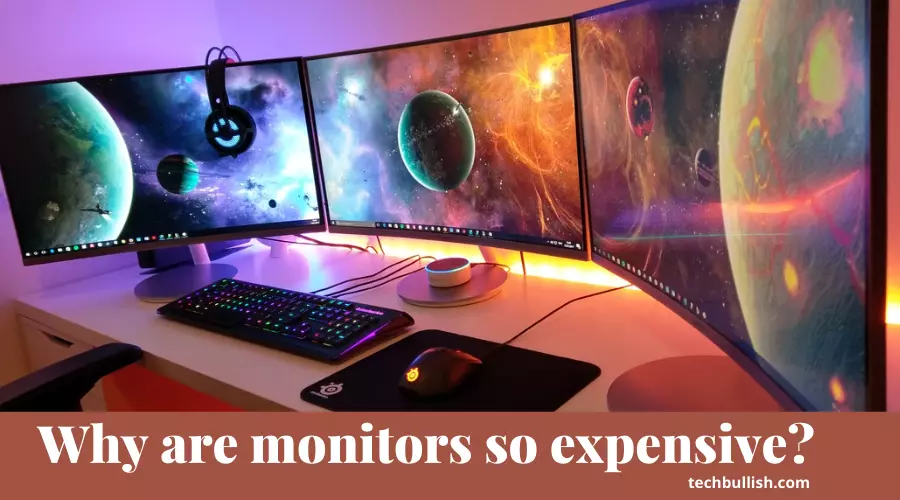There are a lot of monitors in the market with premium cost and there are several ones available in a budget. Here in this post, I will explore all the reasons for this premium pricing of monitors.

Let’s get started!
Reasons Why Monitors Are Expensive
Monitors are specially made screens with many high-end features it as a better refresh rate, response time, PPI, and a lot more features packed for high performance, which are not present in the case of a TV.
We generally find monitors are much more expensive than TVs available in the same budget.
Here are the factors that contribute to the high prices of the monitors:
1. Size of Monitor
The larger the monitor, the more expensive it is, and this is because the larger monitors require more materials and labor to produce.
2. Resolution of the monitor
The higher the resolution of a monitor, the more expensive it is.
3. The features of the monitor
Some monitors have extra features, such as built-in speakers or USB hubs.
4. The technology involved in making a large-screen LCD
LCD screens have lots of small pixels, and the more pixels there are, the higher the screen’s resolution will be.
Also, monitors come with an Ultrawide aspect ratio and super ultrawide aspect ratio, increasing their manufacturing price.
5. Innovations
Innovation has been there in monitors to eliminate screen tearing, image ghosting, and more during gameplay.
Also, the panels are improving and solving the issue of IPS Glow or Backlight bleed in monitors, which we commonly see in IPS panel monitors.
The monitor itself only costs a small fraction of the price when you buy a monitor.
The rest of the price tag is the technology and engineering that went into the making of the monitor, which is what makes the monitor so expensive.
It’s important to note that monitors have a lot of technology and engineering that goes into them.
Big brands invest a lot in their research and development to bring out the technology updates to the monitors which also makes the cost of the monitor higher.
Why are gaming monitors expensive?
Today, gaming monitors are the best monitors on the market.
You will experience the best gaming experience with a gaming monitor if you are a gamer.
If you check the price of Gaming monitors, you will find they are more expensive than any general monitor.
Gaming monitors come with many features, making them quite expensive.
There are also a few other factors that contribute to their high prices.
Technology Advancement and Innovation
Advancements in technology allow manufacturers to include smaller, more high-tech components in the design of gaming monitors.
There has been continuous technological progress, which led to many innovations, and these innovations have contributed a lot to the gaming world.
Advanced technologies like G-Sync, FreeSync, and VSync have been introduced to gaming monitors to keep them in sync with Frame Rates supplied by the GPU.
So, you do not see any screen tearing during gaming.
Better Refresh Rate and Response Time
Most gaming monitors come with a refresh rate of at least more than 60Hz, commonly 70Hz or even up to 144Hz is seen.
These gaming monitors provide a better gaming experience than standard monitors.
The response time of the gaming monitors is very low, and the response time of the monitors is less than 10 ms or less, even if you can see up to 0.5 ms response time.
Gamers can easily enjoy the gaming experience with the help of these gaming monitors.
These features add up to the monitor’s manufacturing cost.
Durability and Quality Screens
First, they are made of high-quality material. These include durable, clear, and quality screens.
They also have high-quality, high-resolution panels and advanced technologies.
Furthermore, they are manufactured by reputable brands with a lot of experience in the gaming industry.
In the case of gaming, you need to have much durability considering you run High Graphics games for long hours.
Ultrawide Aspect Ratio (21:9 and 32:9)
Gaming monitors demand more screen space in the horizontal area as our gaming graphics need more immersiveness.
Hence, Ultrawide monitors are available that have an aspect ratio of 21:9 and have become popular for gaming, work, and more.
We also see an upgraded version of Ultrawide available, the Super Ultrawide with a 32:9 aspect ratio, and even 49″ versions of these gaming monitors are available.
These monitors get you to the best of productivity, and in terms of gaming, if you love the immersiveness in your gameplay, then the Ultrawide monitors are awesome.
These newer aspect ratios and larger screen technologies with more horizontal expansion rather than a more vertical area make monitor manufacturing costs higher.
Why are monitors more expensive than TVs?
Purchasing a monitor instead of a TV is usually more expensive. This is because:
1. Monitors have a higher resolution than TVs, which means they can display more pixels on the screen, resulting in a sharper and clearer image.
2. TVs are typically larger than monitors, requiring more materials and higher costs.
3. Monitors come with various features, such as built-in speakers, USB hubs, card readers, and even fans. These features often drive up the price of the product.
4. Monitors are typically used for gaming, business, or design work. These applications require more advanced technology than TVs, which increases the monitor’s price.
5. TVs are becoming less and less popular as people shift towards using monitors for their computing needs.
This has caused the price of monitors to drop, while the cost of TVs remains relatively high.
6. Monitors are designed to be used on a desktop or tabletop, requiring an external power source and more cable connections.
7. Monitors come with a newer Ultrawide aspect ratio that is far more immersive than TVs, and this newer display aspect ratio makes these display manufacturing more cost-intensive.

I’m Anirban Saha, Founder & Editor of TechBullish. With a B.Tech in Electronics and Communication Engineering, and 5+ years of experience as a software developer, I have expertise in electronics, software development, gadgets, and computer peripherals. I love sharing my knowledge through informational articles, how-to guides, and troubleshooting tips for Peripherals, Smart TVs, Streaming Solutions, and more here. Check Anirban’s Crunchbase Profile here.
